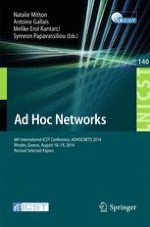2014 | Buch
Ad Hoc Networks
6th International ICST Conference, ADHOCNETS 2014, Rhodes, Greece, August 18-19, 2014, Revised Selected Papers
herausgegeben von: Natalie Mitton, Antoine Gallais, Melike Erol Kantarci, Symeon Papavassiliou
Verlag: Springer International Publishing
Buchreihe : Lecture Notes of the Institute for Computer Sciences, Social Informatics and Telecommunications Engineering
